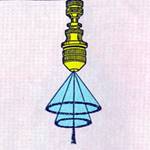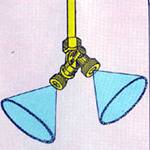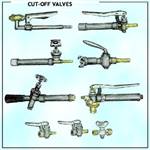Nozzle
-
The nozzle performs four basic functions
-
Atomizes liquid into droplets.
-
Disperses the droplets in a specific pattern.
-
Meters liquid at a certain flow rate.
-
Provides hydraulic momentum.
The Nozzle Tip is one of the most important and least expensive part of a spraying system.
Adjustable nozzle
-
Most suitable for spraying targets which are not within the reach of a man.
-
Gives a wide angle hollow cone to a straight solid stream that is, it gives a jet to a cone type of spray pattern.
-
Difficult to calibrate as the flow and droplet sizes vary widely with the nozzle angle.
Double swirl spray nozzle
-
Used for spraying in two different directions simultaneously.
-
Nozzles can be fitted with different types of tips like hollow cone, solid cone or flat fan.
-
Suitable for high volume applications
-
The shape and size of Nozzle Tip orifice controls the spray angel, discharge rate and spray pattern. Spray angle influences the swath of a spray.
-
And also:-Droplet size increases as orifice size increases (for any given pressure). Droplet size decreases with an increase in fan angle (for any given nozzle size and pressure). When it is desired to spray with more than one nozzle with the help of a spray rig or a spray boom, care should be taken in mounting to avoid overlapping or gapping.Overlap causes double dose Higher dose is harmful to crop Gap leaves untreated area Poor biological efficacy
Selecting a spray nozzle
-
The proper selection and use of spray nozzle is the most important part of pesticide application.
-
The nozzle determines the amount of spray that is generated over a given area, the uniformity of the spray produced, the coverage obtained and the amount of drift that occurs.
-
The nozzle selected must optimize coverage application rate and pressure and minimize loss through drift. For each kind of application, dependent upto the physical conditions prevailing, a different nozzle design is available.
-
Nozzle tips are usually available in brass, stainless steel, and engineering plastic. Steel tips are most resistant to corrosion and abrasion.
-
Brass tips are very commonly used, but ear out more easily and can be corroded by some chemicals. Engineering plastic is likely to become the most serviceable material for spray nozzles, being highly resistant to wear-and-tear and corrosion.
Hollow cone nozzles-Disc and core type
Flat fan nozzles
 |
-
These are used largely for broadcast spraying, where foliar penetration and coverage are not essential.
-
The best operating pressure for flat fan nozzles is 15 – 30 psi, which produce coarser droplets that are not susceptible to drift.
|
Floodjet nozzles
 |
-
These are ideal for high application rates and speeds, because they produce a wide-angle, flat fan pattern.
-
Operating flood-jet nozzles at 5-25 psi minimizes drift, but pressure changes critically affect the width of the spray pattern.
-
Generally, the spray generated by the floodjet is not as uniform as the flat-fan type.
|
Adjustable nozzles
 |
Single swivel nozzles
|
 |
Double swivel nozzles
Double fixed nozzles
-
Double fixed nozzles are fixed on the ‘U’ bend, which is, in turn, coupled with the end of a straight extension rod.
-
NOTE: Single swivel, double swivel and double fixed nozzles come in both cones-spray and flat fan varieties.
|
| |
|
 |
Spray boom
Spray guns
-
Spray guns consist of cut-of-value extension rod and nozzle and can be trigger or hand-operated.
-
The spray pattern is adjustable from solid jet to hollow cone, and are most widely used for tall trees.
|
Cut-off Valves
-
These can be spring-activated (trigger control) or operated by means of a simple knob or trap.
-
A strainer can be built into the control valve handle, and in the trigger type a pressure regulating device can also be incorporated.
Every sprayer should have
Every Spray Lance must have
Extension Rod
-
Comes in varying lengths, according to customer requirements but lengths longer than 90 cms are difficult to handle.
-
For tree spraying, bamboo lances i.e. brass tubes inserted into a hollow bamboo are recommended.
-
The larger diameter of the bamboo helps to off-set the length of the lance (up to 2.5 meters, making it easier to handle).
|






